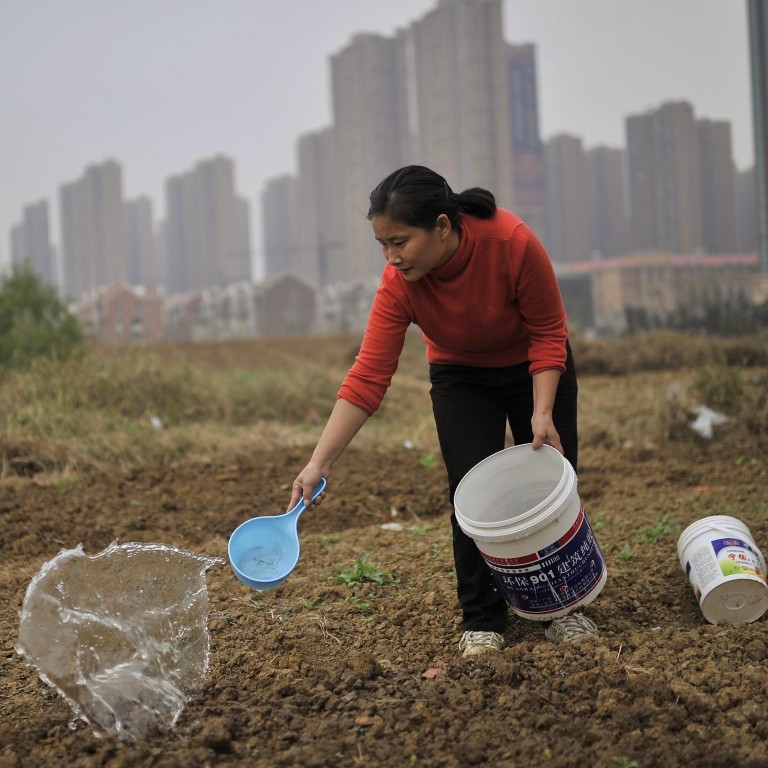
Coronavirus: could China’s rural land reform plan unleash a new round of economic growth?
- Beijing is being urged to press on with land reform to offset the economic impact of the coronavirus
- China’s household registration system and land-use laws have faced criticism for worsening the nation’s urban-rural divide and dragging on growth
Chinese reformers are urging the government to push forward with a long-awaited rural land reform plan they argue will unleash growth, as the coronavirus pandemic and disputes with major trading partners reshape the economic environment.
Some observers believe land reform will provide the world’s second largest economy with a boost in the way that housing privatisation did in 1998 and China’s ascension into the World Trade Organisation did in 2001.
Though that is still a matter of debate, many economists think a broader sharing of land revenue would not only help rural residents hit hardest by the pandemic, but also increase their income and spending. It would also allow many to resettle in cities where they could find higher-paying jobs.
China has maintained tight control over land since public ownership began in the 1950s. Over the past three decades, local governments have used their powers to seize rural land deemed necessary for industrial projects and property development.
Forced relocations, which are often only compensated by meagre payments, have sparked mass protests and helped widen the wealth gap between rural and urban citizens.
Roughly 291 million rural residents, about 38 per cent of the national workforce, had shifted to cities for better paid jobs by the end of last year. But these migrants are forbidden from selling their idle farm homesteads.
This has fuelled a huge wealth disparity in China, where per capita disposable income of urban residents was about 2.5 times that of rural residents in the first quarter of 2020, according to the National Bureau of Statistics.
The current round of reform is comparable to the rural land contract system led by Deng Xiaoping in the 1980s or the land auction system from the 1990s
Huang Qifan, deputy chairman of the Beijing-based think tank China Centre for International Economic Exchanges, said the new initiatives were reminiscent of earlier reforms China embarked on from the late 1970s.
“The current round of reform is comparable to the rural land contract system led by Deng Xiaoping in the 1980s or the land auction system from the 1990s,” he said.
There was about 6.7 million hectares of idle rural land at the end of 2018, the Chinese Academy of Social Sciences estimated in its rural development report for that year. Total rural land set aside for construction of homes, factories and buildings amounted to about 19 million hectares.
Land reform “could create dozens of trillions of yuan of dividends in coming decades and will inevitably promote the better development of urbanisation and rural modernisation,” Huang said at an event organised by China Finance 40 Forum, a pro-reform group, earlier this week.
During his eight-year tenure as mayor of Chongqing, a southwestern municipality of 30 million people, Huang initiated a bold pilot programme to accumulate idle rural and collectively-owned land, creating new land-use rights that could be traded on a local exchange.
While the system ensured sufficient land supply to keep house prices under control, most the proceeds from land transfers went into farmers’ pockets.
Liu Shouying, dean of Renmin University’s school of economics, said land reform offered a chance for China to narrow the urban-rural wealth gap and revitalise the economy, as cheap land and labour was the foundation for decades of strong growth.
“Unlike the previous growth model, reform of China’s land system should be used to facilitate economic transformation,” he said.
“The basic principle is to grant equal rights in the use of urban and rural land and give farmers more property rights during urbanisation.”
Urbanisation, particularly the development of city clusters, is widely believed in Chinese policymaking circles to be a key ingredient for future economic expansion.
The rigid system means rural migrants are unable to fully integrate into cities they work in.
Tang Huahu, a merchant who has lived in Shenzhen for more than 15 years, said under the system his two children could not attend a local public school and may instead have to return to his hometown for education.
When part of his farm was expropriated by the government for the construction of an industrial estate several years ago, Tang’s family of five received about 100,000 yuan (US$14,000) and inclusion in the local pension programme.
But the compensation was so low that he cannot even afford to buy two square metres of property in Shenzhen, or an average-sized flat in the downtown area of his hometown.
“We will just wait and see,” said the 42-year-old, hoping to fetch a higher amount for his remaining farmland. “Maybe I will return to my hometown when the kids grow up. Hopefully, things will get better at that time.”
Beijing has had only limited success in addressing land reform in the past, raising doubts about how far it can go this time.
A 2013 reform document pledged to create a market that allowed collectively-owned land to be traded for development projects, but progress has remained slow in the pilot projects in 33 counties.
Beijing has also recently reiterated that a minimum of 120 million hectares of arable farmland is needed to ensure food security.

